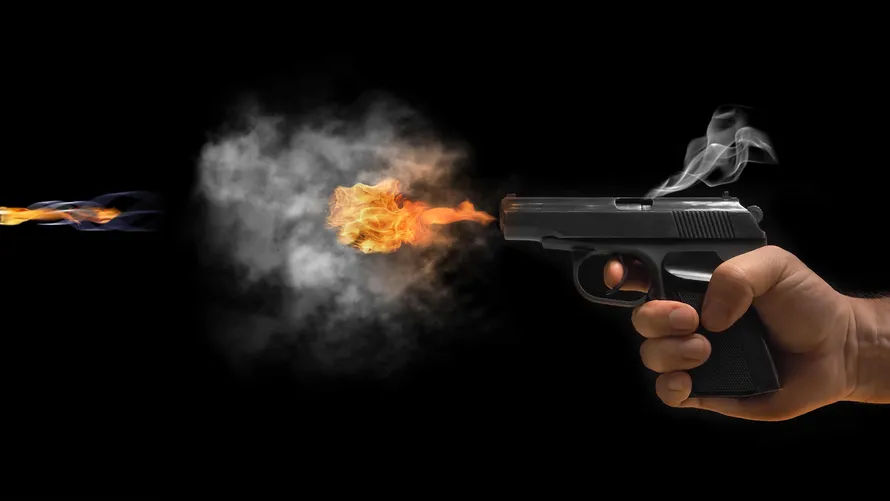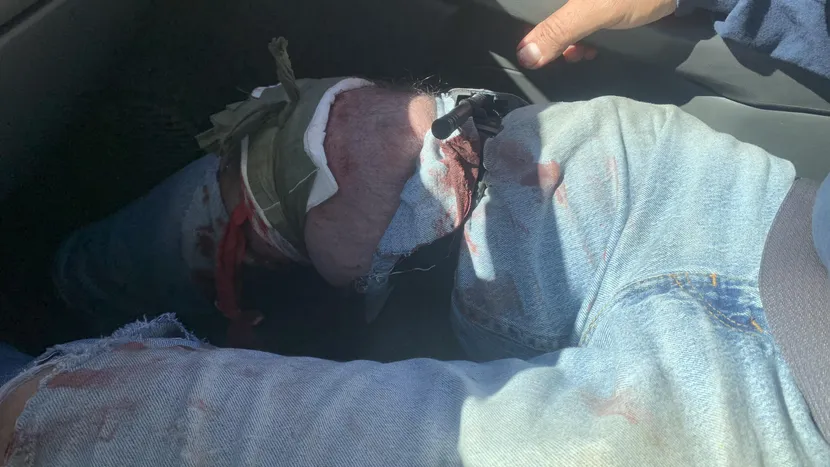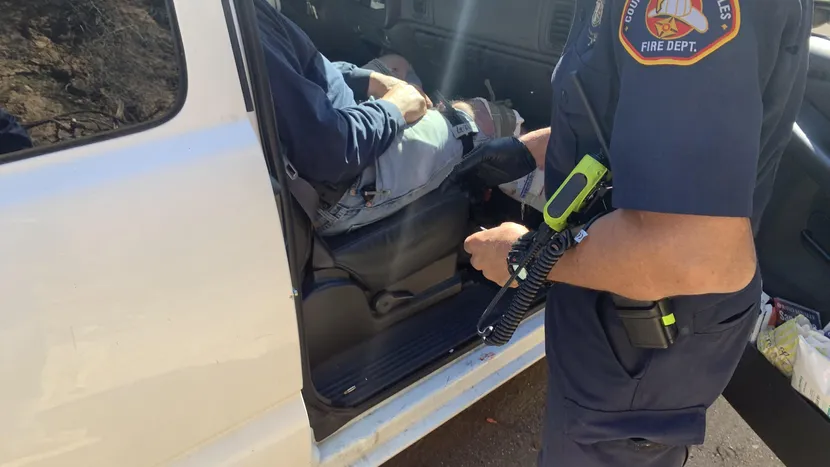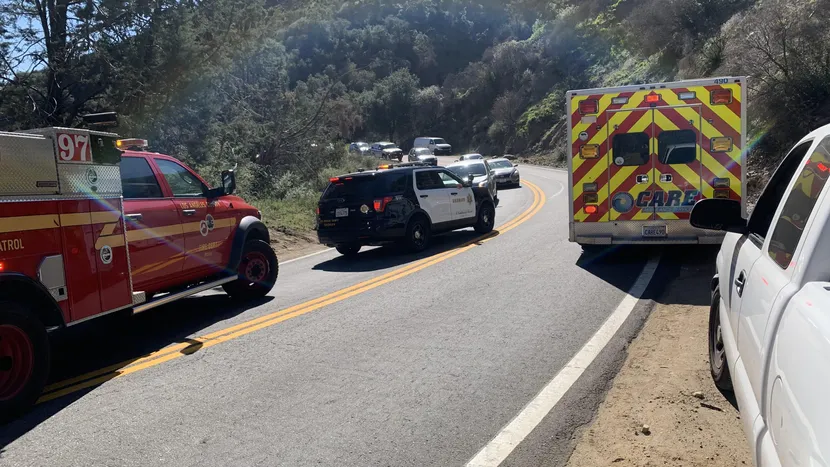March 05 | 2022

WARNING: This article contains graphic photos of actual injuries and may not be suitable for all readers.
This incident took place on February 12, 2022. On the target line, I had just finished demonstrating a “contact shot” against a human silhouette paper target. My beginning firearms students were amazed that the gas from a cartridge could blow a hole in a human body the size of a grapefruit. (Check out my YouTube video on contact shots to see this technique and its power.
Just as I finished the lecture, I heard a popping sound behind me. I turned and saw that my Range Safety Officer (RSO) was sitting on a bench at one of the loading tables. Hmm, that’s odd, I thought. Why is he sitting alone and not directly behind us doing his job?
A loading table on a live-fire range is exactly that: a table where shooters load and unload their magazines. At no time should a firearm be handled there, especially when people are downrange.
My RSO yelled, “Jimmy, I just shot myself!”
Seeing the panic on his face and watching him look down at his lap, I jogged the 20 meters to the loading table. As I approached, I could see that the gas from his pistol had ripped away enough of his jeans to expose a gaping bullet wound below his kneecap. It wasn’t just a gunshot wound; it was the result of a contact shot, the very subject I had been talking about.

Three hours earlier, I had given a safety briefing to my students and my RSO. I even handed each of them a hard copy of my range rules. Included in my briefing were the procedures to be followed should anyone get shot. I explained how first aid was to be administered, how my pickup was to be used as an ambulance, how the range staff was to be notified and how the staff would let the paramedics know that our driver would meet them at the bottom of the mountain.
I barked out, “Teresa, go tell the range office what happened and have an ambulance meet us at the bottom of the mountain! Luis Junior, go get my first aid kit that’s sitting on the tailgate of my truck! Luis, throw all the range stuff in the bed of my truck! I’ll put him in the front seat.”
There was no need to lay the victim down, as I had mentioned in the safety briefing, because he was ambulatory, which means he was conscious and could walk to the truck himself.
Luis Junior handed me the medical bag. As I slipped on my Nitrile gloves, I asked my RSO, “How did this happen?”
In shame, he answered, “I was trying to clear my gun, the slide slipped out of my hand, I tried to catch the gun, and it went off. It just went off!”
Guns just don’t go off, I thought. But I kept it to myself. Stopping the bleeding was my priority. I deduced that he had been pointing the muzzle toward the right berm, not downrange where my students and I had been standing. At least, he had enough sense not to do that.

I realized that my Combat Application Tourniquet (CAT) was still attached to the ballistic vest I had thrown in the back of my truck before the demonstration. I had placed it there because it was the last lesson of the day and all the students’ unloaded weapons had been benched on the loading tables. All weapons, that is, except my RSO’s gun because he needed it on him at all times in case we were attacked by robbers (which had taken place once at that range) or in case an armed student turned homicidal (which happened to renowned Navy SEAL sniper Chris Kyle in 2013).
There’s no time to waste getting the tourniquet from the truck, I thought, even though it was only 15 feet away. I pulled out the alternative, a SWAT-T tourniquet. It’s not that the SWAT-T is a less-effective tourniquet, but I preferred the CAT tourniquet because I had trained with it and carried one for 10 years as a soldier.
As I was about to rip open the plastic wrapper of the SWAT-T tourniquet, an instructor from the bay next to ours came over with a CAT tourniquet. “Just what I need,” I said, amazed at the timing.
As the fellow shooting instructor slipped the loop over my RSO’s leg, I started “packing the wound” with QuikClot Combat Gauze, a hemostatic dressing. My index finger went deep inside the exit wound as I pushed in the long strip an inch at a time.
As the tourniquet was being tightened, I pulled out a standard military pressure bandage. I placed it directly over the wound, then made sure the knot was putting pressure where it was needed. “All right, the bleeding has stopped,” I said. “Now it’s time to transport.”
I started driving down the two-lane mountain road. Halfway down, we encountered a paramedic truck. I waved to get his attention, and he stopped. My RSO answered the paramedic’s questions as his vitals were being checked. Two minutes later, an ambulance pulled up, and the crew placed him in the back of the vehicle.
After the brief questioning, I asked, “Which hospital are you transporting him to?” The young man gave me the name of the hospital and added, “But we’re going to take him back up the hill because we have a helicopter waiting for him.”
I was later told that they knew it would take an hour to get him to a trauma center, especially since rush hour was developing, so they activated the helicopter as soon as the call came. Once I reached the base of the mountain, I saw the helicopter fly over, and the sight comforted me because I knew that my friend would soon get the medical care he needed.
My RSO was lucky. The bullet had missed the artery in his leg and all bones. It was only a flesh wound, and he was able to walk out of the hospital several hours later. Although it was a costly lesson for him, there are some things you can learn from the incident. The primary one is “A TIP,” and it can save a life should you or someone you know ever suffer a gunshot wound or knife wound.



A TIP
A TIP is an acronym, one that I devised to speed up mental processes during this type of emergency. The letters stand for Assess, Tourniquet, Insert, Pressure. The basic medical kit that’s needed can be easily carried in a pocket or pouch. It includes a tourniquet, hemostatic gauze and pressure dressing.
“A” is for Assess the situation.
This is the first thing you must do. When it comes to gunshots, there is always an entrance wound but not necessarily an exit wound where you would expect. Handgun bullets can easily spin off into another direction if bone is encountered. Someone can be shot in the chest, and the bullet can hit a rib and veer off, traveling the length of the body before exiting at the heel. This is why a complete body pat down must be given when doing triage.
“T” is for Tourniquet the injured limb.
Since I did not have an exit wound — or so I thought at the time — I had to assume that the artery had been hit inside the leg and that he could have been bleeding to death internally. Whenever you suspect a limb artery of being severed, the best thing to do is immediately put on a tourniquet. You must stop the bleeding by restricting blood flow at a point between the injury and the heart.
Since the gunshot wound I saw was below the knee and there was charring just above the knee, the tourniquet was applied above that to be on the safe side. The tourniquet had been on for an hour, and no injury resulted from having the blood supply to his leg stopped for that long — at least not in this case. Obviously, if there is no arterial bleeding, indicated by bright red/pink spurting blood or by the limb swelling, you can skip to the next step.
“I” is for insert.
Civilians are usually advised to place hemostatic gauze on top of a gunshot or knife wound and then apply pressure. That’s great advice, but having been military and law-enforcement trained, I’ve been taught to “pack the wound.” You wouldn’t want to do that with regular cotton gauze because it can cause problems for the doctors, but with products like QuikClot or Celox, which are hemostatic gauzes, that’s the proper procedure.
I stuffed the wound until no more would go in. Not much was needed for this particular wound, but a lot would be required for a bullet hole in a thicker part of the body.
“P” is for pressure on the wound.
Even though there is a tourniquet to stop arterial bleeding and the wound is packed with hemostatic gauze, you still need a pressure dressing to make sure that no gauze slips out and that the additional blood-absorbing material helps stop the bleeding and keeps the wound from being contaminated.
If want to train yourself or others to do this, I suggest you purchase the following items: Nitrile or latex gloves, a tourniquet, hemostatic gauze, a pressure dressing and a pool noodle. (That’s right — one of those long, colorful flotation toys kids use.)
For a gunshot wound, you can puncture the pool noodle with a pen to simulate an entrance wound. If you desire, the other half of the noodle can be stabbed or sliced with a kitchen knife to simulate a blade wound. For your training scenario, you can choose to have arterial bleeding or not. If you decide that there is arterial bleeding, tell yourself you have less than a minute before the victim bleeds out. That’s when you should say out loud “TIP — tourniquet, insert, pressure.”
Immediately apply the tourniquet according to the instructions it came with. Next, insert the hemostatic gauze into the wound. The advantage to having a pool noodle as a training tool is it’s hollow, which allows you to “stuff the wound.” Finish tending the wound with a pressure dressing, making sure the knot is directly over it. Of course, using a stopwatch will allow you to know how long it takes. The faster you can do it, the better. Saving as much blood as possible is the goal.
Obviously, the advice provided here is for information only. It does not replace an instructor-led first aid course given by an organization such as the American Red Cross or the American Heart Association. Courses can be taken online for a nominal fee. While you’re at it, consider taking a CPR (cardiopulmonary resuscitation) course and an AED (automated external defibrillator) course.
BE A HARD TARGET
